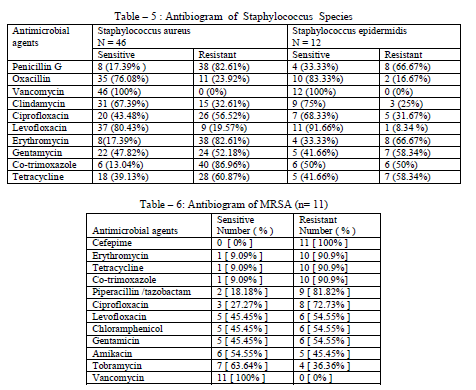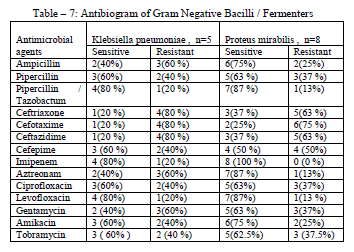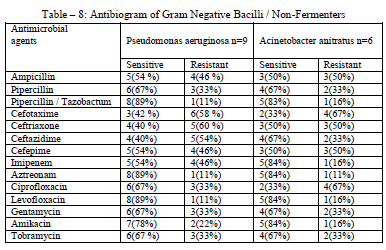IJCRR - 5(20), October, 2013
Pages: 52-58
Date of Publication: 02-Nov-2013
Print Article
Download XML Download PDF
BACTERIOLOGICAL PROFILE OF OSTEOMYELITIS IN A TERTIARY CARE HOSPITAL AT VISAKHAPATNAM, ANDHRA PRADESH
Author: G. Suguneswari, A. Heraman Singh, Ranjan Basu
Category: Healthcare
Abstract:Objectives: Osteomyelitis has been continuing as the most important cause of morbidity among patients with bone infections. Even though early detection of cases and advanced treatments are in process, osteomyelitis is still continued as a major problem due to treatment failures and multidrug resistance. This study was conducted to determine the bacteriological profile of osteomyelitis and their susceptibility pattern to various antimicrobial drugs. The information would guide clinicians in treating osteomyelitis at the initial level so that chronic osteomyelitis can be prevented. Materials and Methods: A total of 100 clinically diagnosed cases of osteomyelitis were included in the study. Clinical specimens like pus, pus swabs, sequestrum of bone and synovial fluid were taken and cultured aerobically. The organisms isolated were identified by routine standard operative procedures. Antimicrobial susceptibility testing was done by Modified Kirby-Bauer's disc diffusion method and the results were interpreted following CLSI guidelines. Methicillin resistance was screened by using Oxacillin disks (1 mcg). Statistical analysis used: Data obtained was presented in counts and percentages and analysed with Fisher's Exact Probability test as applicable. Results: The predominant organisms isolated were Staphylococcus aureus (53.48%) followed by Staphylococcus epidermidis (13.95%), Pseudomonas areuginosa (10.46%), Proteus mirabilis (9.30%), Acinetobacter anitratus (6.97%), Klebsiella pneumoniae (5.82%). Cultures were sterile in 14 % of the cases. Among the isolates of Staphylococcus aureus, 30.33%. were methicillin resistant (MRSA). Most of the Gram positive bacteria were susceptible to Vancomycin, Levofloxacin, Piperacillin/ Tazobactam and Imipenem whereas Gram negative bacteria were susceptible to Piperacillin / Tazobactam, Imipenem, Levofloxacin, Amikacin and Tobramycin. All Methicillin resistant staphylococcus aureus (MRSA) strains were sensitive to Vancomycin. Conclusion: Emerging multidrug resistant strains is a major concern to treat Osteomyelitis. Appropriate selection of antibiotic would help to treat the disease successfully and limit the emergence of drug resistant strains to prevent morbidity and mortality.
Keywords: Osteomyelitis, MRSA, Antimicrobial susceptibility, Multi drug resistance.
Full Text:
INTRODCUTION
Osteomyelitis is a bone infection which occurs due to the extension from an infected joint or by direct invasion as a result of trauma or instrumentation (1). Introduction of microorganisms into the bone may occur during stabilization of the fracture, implanting prosthesis or due to trauma. Prosthetic implants create an environment which favors microbial colonization and establishment of infection successfully in the bone (2). The infective agents adhere to foreign material in the body and secrete glycocalyx that inhibits the host defense mechanism and action of antibiotics so that infection can be established which would be difficult to eradicate (3).
The incidence of osteomyelitis has been lowered to a certain extent due to the rapid diagnosis and the availability of multiple antibiotics along with modern treatment facilities(4); but still, osteomyelitis is an ongoing problem due to emergence of multi drug resistant strains among bacterial pathogens like Staphylococcus aureus and Pseudomonas areuginosa .Inappropriate and excessive use of antibiotics is considered as the main cause of development of drug resistance. Diagnosing the etiological agent and appropriate use of antibiotics are crucial in the treatment of infection preventing further complications (5). The present study was conducted to study the bacteriological profile of osteomyelitis along with the antimicrobial susceptibility patterns so as to establish empiric therapy guidelines at the hospital set up.
MATRIAL AND METHODS
A total of 100 clinically diagnosed cases of osteomyelitis attending the Orthopedic OPD and IPD of Andhra Medical College, a teaching and tertiary care government hospital at Visakhapatnam, during the period between Nov 2002 and Nov 2005 were included in this study. The important factors taken into consideration were the patient's age, sex, occupation, bone involved, signs, symptoms, duration of the illness and predisposing risk factors. Specimens like pus, pus swabs, sequestrum of bone, synovial fluid were collected under aseptic precautions. The samples were processed aerobically using routine standard operative procedures. The culture isolates were identified by Gram stain morphology, colony characters and biochemical reactions(6,7) . The isolates were then subjected to antimicrobial susceptibility testing by Modified Kirby-Bauer disc diffusion method and the results were interpreted as per CLSI guidelines (8). Antibiotics tested were Penicillin G (10 IU ), Ampicillin (10 ug), Pipercillin (30ug), Pipercillin / Tazobactum (100/10 ug), Oxacillin (1ug), Vancomycin (30ug) , clindamycin (2 mcg), levofloxacin (5 ug), Ciprofloxacin (5ug), Erythromycin (5ug), Amikacin (30ug), Gentamycin (30 ug), tobramycin (10 ug), Co-trimoxazole (1.25/23.75 ug), Tetracycline (30 ug), ceftazidime (30 ug), cefotaxime (30 ug), ceftriaxone ( 30 ug), cefepime (30 ug), aztreonam (30 ug), imipenem (10 ug). Screenings of methicillin resistant strains was done by using Oxacillin (1ug) discs. ( HI MEDIA , MUMBAI )
Data obtained in the study is presented with counts and percentages and Fisher’s Exact Probability test was used to calculate p value.
RESULTS
Male preponderance was observed in this study and accounted for 87.5%. The age group which involved majorly with osteomyelitis was between 30-40 years ( 29 % ) followed by 20-30 years ( 23 % ) , 10-20 ( 17 % ) , 40-50 ( 15 % ) , 1-10 ( 8 % ) and 50 and above (7%). The major predisposing factor identified was accidents (53 %) , followed by post surgical wounds (26 % ) , and prosthesis and others (20 %) as shown in Table –1 and observed to be statistically significant [P value – 0.0134 ( < 0.05 ) ].
The commonest bone affected in this study was tibia with 58%, followed by femur, 31%, humerus, 3% , ulna, calcaneum, and phalanx of each 2% and radius, front temporal bones of 1% each respectively ( Table – 2 ).
Socioeconomic status of the cases was analyzed and almost 63% cases affected were from the lower income group and 37 % were from the middle income group; no involvement of higher income group with osteomyelitis was observed in this study. This could explain how the lower socioeconomic group has a relation between the occupation and the disease.
Among the hundred cases studied, culture positivity was obtained in 86 cases (86 % ). The dominant organism obtained in the present study was Staphylococcus aureus (53.48 %), and the rest of the isolates were Staphylococcus epidermidis (13.95%), Pseudomonas areuginosa (10.46 %), Proteus mirabilis (9.30 %), Acinetobacter anitratus (6.97%), Klebsiella pneumonia (5.82%) (Table –3). Among Staphylococcus species, 23.92 % were MRSA and 76.08 % were MSSA (Table – 4).
Antibiotic susceptibility patterns of Staphylococcus species, MRSA, Gram negative bacilli / fermenter and Gram negative bacilli / non-fermenter have been presented in Table – 5 ,Table – 6, Table – 7 and Table – 8, respectively .
DISCUSSION
Osteomyelitis is one of the most inconvenient diseases among most of the developing countries like India. An increase in the emergence of drug resistant strains makes treatment even more complicated. Hence, area-wise studies on bacteriological profiles and their antimicrobial susceptibility pattern are essential to guide policy on the appropriate use of antibiotics.
The incidence of osteomyelitis was observed high among males and in age groups between 20-40 years which states that the younger age groups are more accident prone in relation to their occupation. Accidents were observed to be the most common predisposing factor in this study and leads to epiphysial cell destruction and hemorrhage which in turn decreases tissue resistance (4). Postoperative wounds and prosthesis were the other risk factors observed in this study. In relation to age wise distribution, our study collaborates with the studies by Muggeridge E. Et al and differs with the study by Waldvogel F. et al which were reported maximum and minimum incidence respectively (9, 10 ).
The common bones involved in this study were lower extremities which are similar to the studies by Kaur J. et al (4) and Muggeridge E. et al (9).
Staphylococcus was the major isolate in this study which coincides with different studies by Rao PS. et al (11), Along TO. et al. (12), Fernandez E.et al (13) and Muggeridge E. et al (9) but differed by the study with Kaur, J et al (4) who observed a lower incidence in children .
Even though the gram negative organisms are increasing rapidly since longer time, still staphylococcus remained the most common isolate of osteomyelitis. On the other hand, methicillin resistant strains are aggravating the disease further. All the MRSA strains were resistant to beta-lactum drugs and multiple antibiotics. The high resistance of MRSA was observed for Ciprofloxacin and Gentamicin which correlates with studies by Kaur, J et al (4) . All the MRSA strains showed 100% sensitivity to Vancomycin and 91.66 % sensitivity to Levofloxacin which correlates with the study by Kaur, J et al (4).
Our study revealed that overall Piperacillin / Tazobactum combination was the most sensitive drug among all the Gram negative bacilli followed by Imipenem, Levofloxacin, Amikacin and Aztreonam. Among the Enterobacteriaceae, Imipenem was more sensitive whereas among Non – fermenters Aztreonam and Levofloxacin were the most active drugs.
Most of the Enterobacteriaceae and GNB, Non-fermenters showed resistance against 3rd generation cephalosporins like Cephotaxim, Ceftazidime, Ceftriaxone etc.
The MRSA isolates showed extensive resistance to most of the commonly used antibiotics like Cefepime (100%), Erythromycin (90.9%), Tetracycline (90.9%), Co-trimoxazole (90.9%), Piperacillin / Tazobactum (81.82%), Ciprofloxacin (72.73%), and Levofloxacin ( 54.55%) .
CONCLUSION
Osteomyelitis has been the major cause of morbidity since long. Emerging multidrug resistant strains is of major concern to treat the disease. Even though gram negative bacteria are being increased significantly but still Staphylococcus aureus is being continued as a major etiological agent of osteomyelitis. Betalactamase production and methicillin resistance pose challenge in the treatment of osteomyelitis. Appropriate and judicious selection of antibiotic by using antibiotic sensitivity data would limit the emerging drug resistant strains in the future to treat the disease successfully. Our study thereby will guide the clinician in choosing appropriate antibiotics which not only contribute to better treatment but there judicious use will also help in preventing emergence of resistance to the drug which are still sensitive .
ACKNOWLEDGEMENT
The authors would like to thank Dr. Y. Narayana Rao, Principal, Andhra Medical College, Visakhapatnam, Dr. M. Subhadra Devi, Professor and Head of the Department of Microbiology and Dr. Ambedkar, Professor and Head of the Department of Orthopedics for their constant encouragement and kind help throughout the period of work.




References:
- Barbara A. ; "Bone and joint infections" ;Text book of infectious diseases; (1996). P-331-339.
- Peter J.Carek, Lori M.Dickson, Jonathan L. Sack; Diagnosis and management of osteomyelitis. ; Am Fam Physicians; June 15, 2001 ; 63(12):2413-2421.
- Topley and Wilson’s Principles of bacteriology, virology and immunity; Systemic bacteriology, vol2, ed-9 ; Edward Arnold, 1998 ; p-557-632,1035-1050,1091-1109 .
- Kaur, J and Gulati VL et al; Bacteriological profile of osteomyelitis with special reference to staphylococcus aureus ; Indian journal for the practising doctor ; 2013 ; 4(6) .
- WHO Library Cataloguing-in-Publication Data ; The evolving threat of antimicrobial resistance: Options for action ; 2012
- Betty A Forbes , Daniel F. Sahm , Alice S. Weissfeld ; Baily and Scott’s Diagnostic Microbiology ; 12th edition ; Mosby Inc.; 2007
- Collee JG, Fraser AG, Barry P Marmion, Simmons A. Mackie and McCartney Practical Medical Microbiology; 14th edition; 1996; Churchill Livingstone, London. .
- Clinical and Laboratory Standard Institute, 2012. Performance standards for antimicrobial susceptibility testing. Clinical and Laboratory Standards Institute, Wayne. 22nd Informational Supplement, 32 ( 3 ).
- Muggeridge E, Mehta M.J, Shardanel M ; "Acute pyogenic osteomyelitis in territory of Australia" ; Journal of joint surgery ; 2002 ; 84-B p-285.
- Waldvogel F, Medoff G, and Widmen AF,." Bone infections" ; New England Journal of Medicine ; 2001 ; vol:33 ; p-198-206.
- Rao PS, Beena VC et al ; "Bacteriological study of bone and joint infections ; Indian Journal of Orthopaedics ; 1997 ; 31(3), p-171-174.
- Along TO, Ogunlade SO, Fashina AN ; Microbial isolates in chronic osteomyelitis- A guide to management from department of surgery, college of medicine, Nigeria ; African journal of medical sciences ; 2002 ; 31(2): 167-169.
- Fernandez E, Juanto M.; Pseudomonas osteomyelitis after puncture wounds of foot in children. ; Journal of Bone and Joint Surgery; vol, 84-B:120,2002.
|






 This work is licensed under a Creative Commons Attribution-NonCommercial 4.0 International License
This work is licensed under a Creative Commons Attribution-NonCommercial 4.0 International License